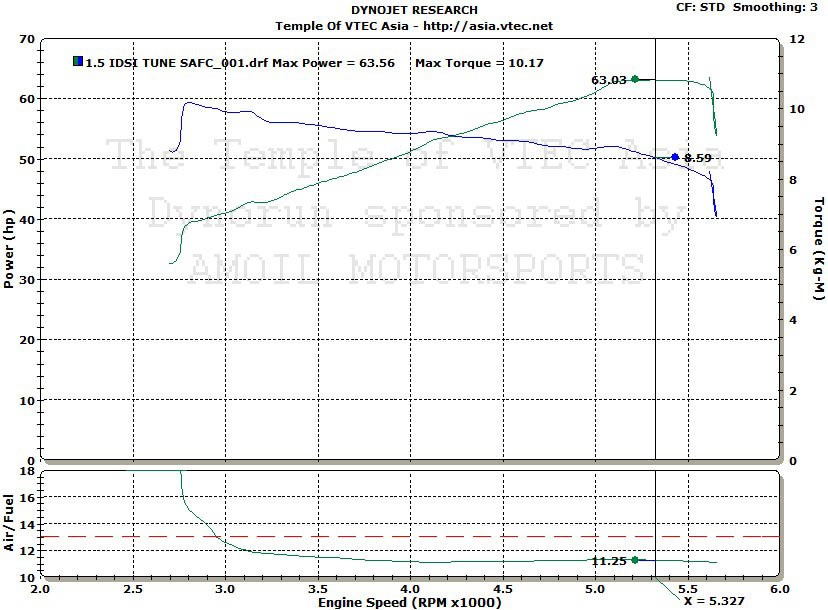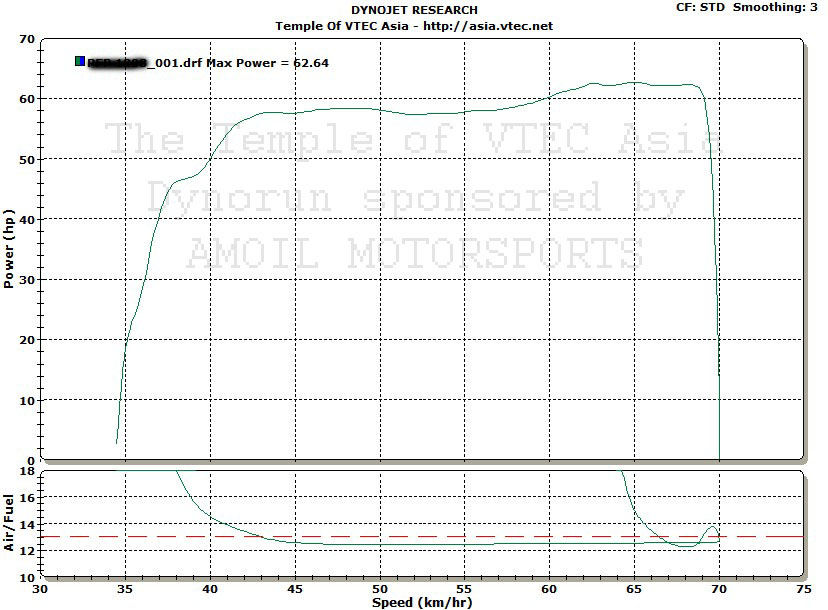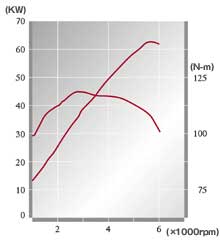

Dyno Results the Asian Fit/Jazz 1.4 & 1.5 i-DSI
We at TOV/TOVA believes that we are probably one of the very first and very few to have published dyno results for the Fit/Jazz VTEC. At the moment we have published the dyno result for the Fit/Jazz VTEC CVT-7 here at TOVA while our main site, the TOV, have just published results for the USDM Fit VTEC 'Sports' 5MT. To complete our dyno-results 'set', here in this article, I will publish the dyno results for both the original 1.4l Fit/Jazz i-DSI as well as the 1.5l Fit/Jazz i-DSI that was developed in Thailand, running with the CVT and CVT-7 gearbox respectively. With this, we at the TOV/TOVA now believes that we have published the most comprehensive set of dyno-results for the Fit/Jazz anywhere.
As with the Asian Fit/Jazz VTEC article, I need to made an acknowledgement to our TOVA dynorun sponsor JC Asia Motorsports or more popularly known to Malaysian Honda enthusiasts as AMOIL Motorsports. The dyno results published here are from their collection and are published on the condition it be done anonymously. In addition, as might be expected, both the cars here went in to AMOIL for dyno-tuning and thus they already have differing degree of modifications to them. Unfortunately AMOIL does not keep a comprehensive record of the cars they dyno so I am unable to identify the exact list of modifications both cars have on them. Nevertheless, taking the results as a general guideline, I believe they will still serve as a most important and useful reference for owners of both models.
To recap, the dyno facility that AMOIL uses is a Dynojet chassis dyno. AMOIL MOTORSPORT's contact number is 60-3-5633-8529. If you intend to visit AMOIL, either for some window shopping or for some work, ask to speak to Jackie Ng and mention that you are referred to him by TOVA.
Dyno Check - Stock Honda Jazz 1.5 i-DSI


We start off with the Fit/Jazz 1.5 i-DSI, using the 1.5l L15A i-DSI that was developed originally for the Honda City/Fit-Aria by HRT in Thailand. Despite having no notes about the amount of mods on this this unit, the rich air-fuel ratio leads me to believe that it is almost completely stock, except for an APEXi SAFC-2 which the owner went in for dyno-tuning. The dyno-chart for the car is again published on the left. Honda never actually published a power/torque chart for the Jazz 1.5 i-DSI so we won't have any for base reference unless we use the one which Honda published for the JDM Fit-Aria which in theory uses the same engine. However the specs shows the JDM L15A i-DSI engine as used on the Fit-Aria to be rated for a max power of 90ps (this is in JIS unit). The figures published by Honda for the L15A i-DSI as used on the (non-JDM) Jazz 1.5 i-DSI and City 1.5 i-DSI are a max power of 65kW/88ps at 5,500rpm and a max torque of 131Nm/13.4kgm at 2,700rpm (these are in SAE units). Nevertheless, the power/torque chart for the JDM Fit-Aria is shown on the right to give us at least some sort of base reference.
The 1.5 Jazz i-DSI dyno'ed almost exactly at 63ps at the wheels. For this dynochart, look at the cursor line and the power indicated there. The max power that is listed on the note is being skewed by the 'kink' right at the end of the curve, adding an extra 0.5hp and should be ignored. Now, if we compare this to its rated engine power and then to the results from the stock Jazz VTEC in our earlier article, then we can see that the result is almost perfectly 'spot-on'. I.e. from a rated engine spec of 110ps for the Jazz VTEC, a dyno'ed power of 80ps at the wheels works out to around 73%. Consequently, 73% of the rated power of 88ps for the L15A i-DSI works out to 64.24ps which very near the figure of 63ps obtained above !
In terms of the results, again the dyno result match the profile of the published stock curves quite nicely. The torque curves for the L15A i-DSI starts to fall after the peak torque point at 2,700rpm and this is generally reflected in the dyno chart above as well. Like all modern Honda engines I have dyno'ed so far, the L15A i-DSI runs rich in stock form, in this case, even richer than the L15A VTEC. Note how consistent the AF ratio is, a bit over 11:1. Again Honda does this generally to ensure a fair amount of safety margin to prevent engine damage from adverse fuel quality and so forth. To the modder's eyes though, this is good news as it means the stock ECU will be able to handle quite a bit of air-flow mods without any real need for AF modifications.
Modifying the L15A i-DSI NA means

Of course the unit dyno'ed above went in to AMOIL for dyno-tuning of an APEXi SAFC-2. So naturally the next crucial question now would be how much did it gain ? Well, TOVA would not the voice of the (hard-core) enthusiasts if we don't answer this question of course !
The 'before and after' result of the dyno-tuning is shown on the left. So after suitably adjusting the AF ratio that the engine is running at from 11+:1 to around 12.5:1, the power output took a nice jump upwards. Again ignoring the artificial result produced by the kink at the end of the curve, the max power after adjusting the SAFC-2 is now almost 67ps at the wheels. Using the base result of 63ps atw, 67ps atw works out to an engine power of around 94ps, up 6ps or around 7% increase. Noting that the engine probably do not have anything else done to it, this is a rather good increase in power. With some additional mods, I believe quite a bit more power should be available from the engine.
Again note how the new curve mirros the original one and how the power gains are consistent all across the rpm range. I think the result shows how much potential is locked up inside the little L15A i-DSI engine as just 'correcting' the aif-fuel ratio of a stock engine can deliver so much additional power. Remember, this engine is supposed to be designed for fuel economy and driveability, not outright power.
Dyno Result for Jazz 1.4 i-DSI
Now that we have looked at the dyno results for the Fit/Jazz 1.5 i-DSI, its time to shift our focus on the 'mother' of this great model, the original 1.3/1.4 (depending on where its sold) Fit/Jazz i-DSI.

Dyno-ing this particular car actually poses an unusual problem. As has been explained numerous times here, the CVT/MMT gearbox does not run with a fixed gear ratio. The original MMT gearbox on the EK3 Civic had straight forward programming which rams the engine rpm right to red-line at WOT and S-mode. But a decade of experience and development has enabled Honda's engineers to fine-tune the operation of this gearbox. Readers who have read my original Fit/Jazz 1.3 review and owners of this car would know that the Fit/Jazz's CVT does not jump directly to redline with WOT. Rather it jumps up to around 4,000+rpm and holds there for a short while before slowly climbing up again. In practise this serves to introduce some artifacts to the dyno result because when the ECU is holding engine revs at 4,000rpm, it is not perfectly steady at that rpm but can fluctuate a bit around this figure. Then from 4,000rpm to the redline, both the engine revs and gear ratio are constantly changing. As a result a dyno chart of the Fit/Jazz 1.3 i-DSI if plotted in the standard power vs engine rpm format can often show some wierd 'loop the loops'. An example is shown on the left to illustrate this unusual characteristic.


With this constraint in mind, the best method to display the dyno result of a Fit/Jazz 1.3 i-DSI is actually to plot the power output against the vehicle's 'ground speed' (i.e. equivalent vehicle speed based on rate of the dyno run rotation) as the independent variable. Thus the dyno-chart for the 1.4 Fit/Jazz i-DSI CVT uses 'vehicle speed' on its X-axis. With this explained, the dyno result for a stock Fit/Jazz 1.3 i-DSI is shown on the left.
The power chart for the L13A i-DSI as supplied by Honda is again published on the right hand side of the dyno-chart. In this case, the chart is for a JDM unit instead of an 'export' version. Now this differentiation is important because the JDM 1.3 Fit i-DSI is actually rated at a higher power than those sold as '1.4 Fit/Jazz i-DSI' outside of Japan as official domestic models. I.e. the JDM 1.4 Fit is rated at a max power of 86ps at 5,700rpm with a max torque of 119Nm or 12.1kgm at 2,800rpm while the 'official export' versions 1.4 Fit/Jazz i-DSI are rated at a max power of 81 to 83ps at 5,700rpm (depending on which country). This difference in rating (of between 5 to 3ps) is due to actual difference in engine specs, again most probably that rather infamous factor of availability of high grade fuel in Japan versus the rest of the world. Support for this is the fact that the JDM L13As are running with a CR of 10.8 : 1 while the export units are running with a CR of 'only' 10.4 : 1. Don't forget the 'export' units need to cater for the lowest denominator i.e. lowest fuel quality in all the countries in which it is sold so the non-JDM versions are typically spec'ed for RON91 fuel.
Bearing this in mind, the dyno-result for the JDM Fit i-DSI CVT is a rather good result of 62+ps at the wheels, hardly 1ps less than what the Fit/Jazz 1.5 i-DSI dyno'ed at ! Of course their respective power ratings are quite similar as well, the rated engine power differing by only between 2 to 5 ps only. Actually if we assume the power rating for a JDM Fit 1.3 i-DSI which is 86ps and apply the same power loss as what we got from the dyno results of the Fit 1.5 i-DSI and Fit 1.5 VTEC, i.e. dyno'ed power at wheels is 73% of rated engine power, we get 73% of 86ps as 62.78ps, again almost perfectly spot on with the result from the dyno ! On the other hand, this being a Malaysian car, the official Malaysian Domestic Market 1.4 Jazz i-DSI as sold by Honda Malaysia is rated at a max power of 83ps. So 73% of 83ps works out to be around 61ps at the wheels which is not a lot less than what was done on the dyno. Both types of Fit/Jazz are common in Malaysia as there were a lot of JDM Fit 1.3 i-DSIs imported by the local parallel importers before Honda Malaysia officially launched the 1.4 Jazz i-DSI for sale here.

I've always found it fascinating how the original L13A i-DSI's power curve shows a slight rise in power in the higher rpms after the max torque point at around 2,700rpm. This is from around 3,000rpm to 4,500rpm and if you take a close look at the stock chart that is published by Honda, you can see that there is a small bump in the power curve, actually more visible in the torque curve. Again this profile is reflected in the dyno'ed result above. It's almost as if there's some mechanism which switches on at 3,000rpm to give a small boost to air-flow into the engine. The air-fuel ratio again runs slightly rich, around 12.5:1 for this unit.
Conclusion
I hope this article provides a very worthwhile complement to our published results for the Fit/Jazz thus far. It should be especially appreciated by TOVA readers and owners of the Fit/Jazz i-DSIs as again we have also seen how well even the i-DSI versions of the Lseries engines are responding to simple air-flow mods. I think this bodes very well for us Honda enthusiasts and fanatics as the new L-series engine looks very much to be a much more than capable replacement for the D-series engines that many of us have 'grown' up using and modifying.
Wong KN
October 2006
© Temple of VTEC Asia and Temple of VTEC